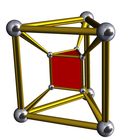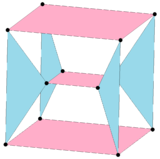Uniform 3-4 duoprisms  Schlegel diagrams | |
|---|---|
| Type | Prismatic uniform polychoron |
| Schläfli symbol | {3}×{4} |
| Coxeter-Dynkin diagram | |
| Cells | 3 square prisms, 4 triangular prisms |
| Faces | 3+12 squares, 4 triangles |
| Edges | 24 |
| Vertices | 12 |
| Vertex figure |  Digonal disphenoid |
| Symmetry | [3,2,4], order 48 |
| Dual | 3-4 duopyramid |
| Properties | convex, vertex-uniform |
In geometry of 4 dimensions, a 3-4 duoprism, the second smallest p-q duoprism, is a 4-polytope resulting from the Cartesian product of a triangle and a square.
The 3-4 duoprism exists in some of the uniform 5-polytopes in the B5 family.
YouTube Encyclopedic
-
1/3Views:6681 071304
-
4-3 Duoprism
-
8/3-7/3 Duoprism
-
7/3-7/3 Duoprism
Transcription
Images
 Net |
 3D projection with 3 different rotations |
 Skew orthogonal projections with primary triangles and squares colored | |
Related complex polygons

The quasiregular complex polytope 3{}×4{}, ![]()
![]()
![]() , in has a real representation as a 3-4 duoprism in 4-dimensional space. It has 12 vertices, and 4 3-edges and 3 4-edges. Its symmetry is 3[2]4, order 12.[1]
, in has a real representation as a 3-4 duoprism in 4-dimensional space. It has 12 vertices, and 4 3-edges and 3 4-edges. Its symmetry is 3[2]4, order 12.[1]
Related polytopes
The birectified 5-cube, ![]()
![]()
![]()
![]()
![]()
![]()
![]()
![]()
![]() has a uniform 3-4 duoprism vertex figure:
has a uniform 3-4 duoprism vertex figure:
3-4 duopyramid
| 3-4 duopyramid | |
|---|---|
| Type | duopyramid |
| Schläfli symbol | {3}+{4} |
| Coxeter-Dynkin diagram | |
| Cells | 12 digonal disphenoids |
| Faces | 24 isosceles triangles |
| Edges | 19 (12+3+4) |
| Vertices | 7 (3+4) |
| Symmetry | [3,2,4], order 48 |
| Dual | 3-4 duoprism |
| Properties | convex, facet-transitive |
The dual of a 3-4 duoprism is called a 3-4 duopyramid. It has 12 digonal disphenoid cells, 24 isosceles triangular faces, 12 edges, and 7 vertices.
 Orthogonal projection |
 Vertex-centered perspective |
See also
Notes
- ^ Coxeter, H. S. M.; Regular Complex Polytopes, Cambridge University Press, (1974).
References
- Regular Polytopes, H. S. M. Coxeter, Dover Publications, Inc., 1973, New York, p. 124.
- Coxeter, The Beauty of Geometry: Twelve Essays, Dover Publications, 1999, ISBN 0-486-40919-8 (Chapter 5: Regular Skew Polyhedra in three and four dimensions and their topological analogues)
- Coxeter, H. S. M. Regular Skew Polyhedra in Three and Four Dimensions. Proc. London Math. Soc. 43, 33–62, 1937.
- John H. Conway, Heidi Burgiel, Chaim Goodman-Strauss, The Symmetries of Things 2008, ISBN 978-1-56881-220-5 (Chapter 26)
- Norman Johnson Uniform Polytopes, Manuscript (1991)
- N.W. Johnson: The Theory of Uniform Polytopes and Honeycombs, Ph.D. Dissertation, University of Toronto, 1966
- Catalogue of Convex Polychora, section 6, George Olshevsky.
External links
- The Fourth Dimension Simply Explained—describes duoprisms as "double prisms" and duocylinders as "double cylinders"
- Polygloss - glossary of higher-dimensional terms
- Exploring Hyperspace with the Geometric Product


